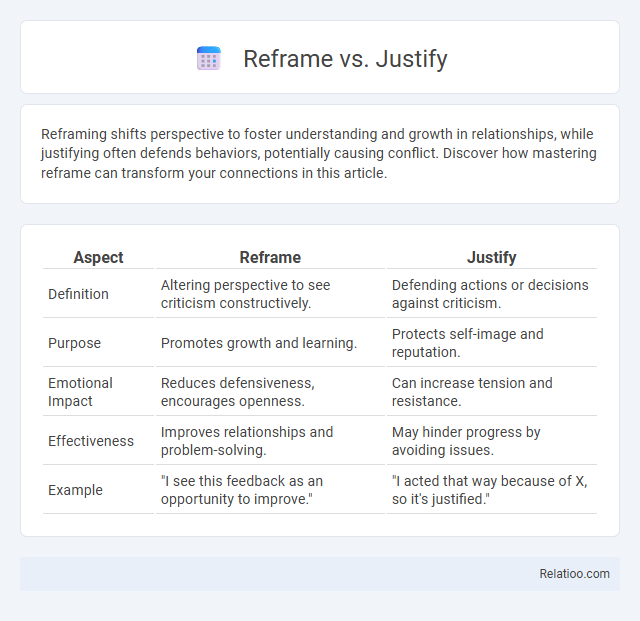Reframing shifts perspective to foster understanding and growth in relationships, while justifying often defends behaviors, potentially causing conflict. Discover how mastering reframe can transform your connections in this article.
Table of Comparison
| Aspect | Reframe | Justify |
|---|---|---|
| Definition | Altering perspective to see criticism constructively. | Defending actions or decisions against criticism. |
| Purpose | Promotes growth and learning. | Protects self-image and reputation. |
| Emotional Impact | Reduces defensiveness, encourages openness. | Can increase tension and resistance. |
| Effectiveness | Improves relationships and problem-solving. | May hinder progress by avoiding issues. |
| Example | "I see this feedback as an opportunity to improve." | "I acted that way because of X, so it's justified." |
Understanding the Concepts: Reframe vs Justify
Reframe involves changing the perspective on a situation to find a more positive or constructive meaning, enhancing cognitive flexibility and emotional resilience. Justify centers on providing reasons or explanations to defend or validate an action or belief, often reinforcing existing viewpoints. Understanding the difference between reframe and justify is crucial for effective communication and problem-solving, as reframing encourages openness and growth, while justifying can limit perspective by anchoring to current assumptions.
Core Differences Between Reframing and Justifying
Reframing involves changing the perspective of a situation to uncover new meaning or solutions, while justifying focuses on defending or explaining actions or beliefs to validate them. Core differences lie in reframing promoting growth and flexibility by shifting viewpoints, whereas justifying often reinforces existing beliefs without encouraging change. Your ability to reframe challenges can lead to personal development, contrasting with justification which tends to maintain the status quo.
The Psychology Behind Reframing
Reframing involves altering the perception of a situation to find a more positive or empowering perspective, which can reduce stress and enhance emotional resilience. Justifying often reinforces existing beliefs by providing reasons, potentially limiting openness to change and maintaining cognitive biases. The psychology behind reframing highlights its role in cognitive restructuring, enabling individuals to shift negative thought patterns and improve mental well-being by creating adaptive interpretations of experiences.
Why People Tend to Justify Actions
People tend to justify actions to protect their self-esteem and reduce cognitive dissonance caused by conflicting beliefs and behaviors. Justification serves as a defense mechanism that helps individuals maintain a positive self-image despite mistakes or negative outcomes. Reframing, by contrast, encourages viewing situations from different perspectives, promoting growth and understanding rather than self-protection.
Positive Impacts of Reframing on Mindset
Reframing transforms your mindset by shifting negative thoughts into positive perspectives, fostering resilience and enhancing problem-solving abilities. Unlike justifying, which often reinforces limiting beliefs, reframing encourages adaptive thinking that promotes emotional well-being and growth. This cognitive shift reduces stress and empowers you to approach challenges with optimism and creativity.
Risks and Consequences of Justifying Behavior
Justifying behavior often leads to minimizing accountability, increasing the risk of repeating harmful actions and damaging relationships. Reframing shifts perspective, allowing you to recognize underlying motives and consequences without self-deception. Your ability to reframe rather than justify promotes growth and better decision-making, reducing the long-term negative impact on personal and professional outcomes.
Practical Examples: Reframing vs Justifying
Reframing transforms your perspective by highlighting positive or alternative angles in challenging situations, such as viewing a failed project as a learning opportunity. Justifying, in contrast, involves defending or explaining actions or decisions, often to avoid blame or criticism, like rationalizing missed deadlines by citing workload. Practical examples reveal that reframing encourages growth and openness, while justifying can limit self-awareness and problem-solving.
When to Reframe Instead of Justify
When you face criticism or conflict, choose to reframe instead of justify to shift the conversation toward understanding and solutions. Reframing helps you acknowledge different perspectives, turning potential defensiveness into open dialogue that fosters empathy and collaboration. Your ability to reframe emotions or viewpoints strengthens relationships and promotes constructive outcomes.
Developing a Habit of Reframing for Growth
Developing a habit of reframing fosters growth by consistently shifting perspectives to find positive or constructive meanings in challenging situations. Unlike justifying, which defends or rationalizes actions based on existing beliefs, reframing encourages open-mindedness and adaptability, essential for mental resilience and personal development. Emphasizing reframing over mere justification cultivates cognitive flexibility, enabling individuals to approach problems with innovative solutions and enhanced emotional intelligence.
Reframe or Justify: Which Leads to Better Outcomes?
Reframe and justify are cognitive strategies used to manage thoughts and emotions, yet reframing involves altering the meaning of a situation to view it more positively, while justifying involves defending or rationalizing an action or belief. Research shows that reframing leads to better psychological outcomes by promoting flexibility and reducing stress, whereas justification can sometimes reinforce negative patterns by entrenching existing beliefs. You benefit most from adopting reframing techniques, as this approach fosters resilience and healthier emotional regulation.

Infographic: Reframe vs Justify
 relatioo.com
relatioo.com